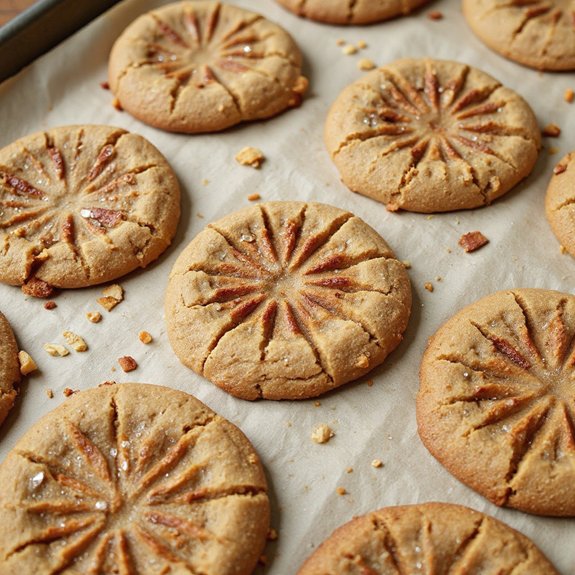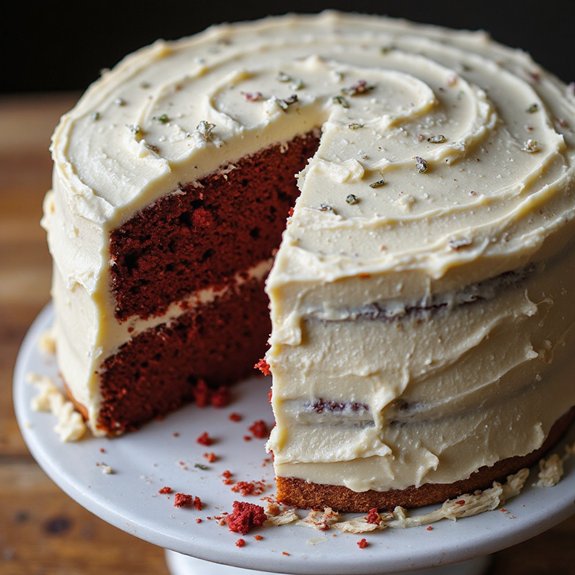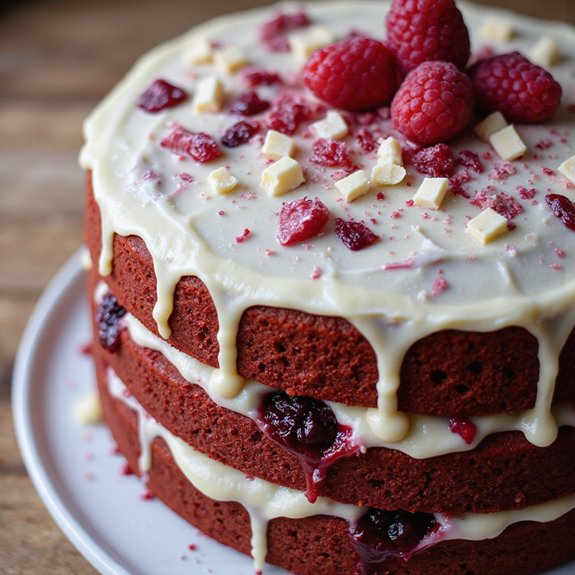Picture warm, golden-brown rounds with crackled tops, their edges slightly crisp and centers plush and chewy, releasing the cozy aroma of roasted peanuts and a whisper of tang from lively sourdough.
Imagine breaking one open: the soft, nubby texture yields to a caramel-scented, nutty sweetness that feels like a hug after a long day.
These cookies matter to me because they turn leftover starter into comfort—nothing wasted, everything welcomed—and they bake up fast enough to soothe a rushed evening.
They’re perfect for busy weeknights, Sunday suppers, or that in-between hour when friends drop by and a pot of coffee is brewing.
Once, during a power-hour homework scramble, a chilled bowl of this dough saved the night—ten minutes in the oven, and suddenly the kitchen felt calm, the kids focused, and dessert was done.
We’ll keep it simple, maximize chew, and coax big flavor from humble ingredients.
Ready? Let’s cook!
Why You’ll Love It
- Delivers deep, nutty flavor with tangy sourdough complexity
- Bakes up irresistibly chewy, soft-centered cookies every time
- Uses pantry staples and your active or discard starter
- Ready fast: quick mix, brief chill, short bake
- Freezes beautifully for effortless, fresh-baked cookies anytime
Ingredients
- 113 g unsalted butter softened — room temp for easy creaming
- 150 g creamy peanut butter — choose natural, well-stirred
- 150 g granulated sugar — superfine dissolves best
- 100 g light brown sugar packed — adds moisture and depth
- 1 large egg room temperature — binds and enriches
- 1 tsp vanilla extract — pure extract for best flavor
- 150 g ripe sourdough starter 100% hydration — bubbly and active
- 190 g all-purpose flour — unbleached for best texture
- 1/2 tsp baking soda — aids spread and browning
- 1/2 tsp baking powder — lifts for a softer chew
- 1/2 tsp fine sea salt — balances sweetness
- 50 g granulated sugar for rolling optional — sparkly, crisp edges
Step-by-Step Method
Mix the Dry Ingredients
Whisk the flour, baking soda, baking powder, and salt in a medium bowl. Break up any lumps for an even blend. Set the bowl aside.
Prepping the dry mix first guarantees quick, smooth mixing later and prevents overworking the dough. Keep the whisk handy for light aeration and uniform distribution of leaveners.
Cream the Fats and Sugars
Beat the softened butter, peanut butter, granulated sugar, and brown sugar until light and fluffy, about 2 minutes. Use a hand or stand mixer on medium speed. Scrape the bowl to capture any unmixed bits.
Proper creaming builds structure and helps create chewy, tender cookies with a balanced peanut flavor.
Incorporate Egg and Vanilla
Add the egg and vanilla extract to the creamed mixture. Beat until smooth and fully combined, about 20–30 seconds. Scrape the bowl and beater as needed.
Don’t overmix at this stage. Aim for a cohesive, silky batter that will readily accept the sourdough starter in the next step.
Mix in the Sourdough Starter
Add the ripe 100% hydration sourdough starter. Mix on low until fully incorporated and no streaks remain.
The starter adds moisture, mild tang, and chew. Make sure even distribution for consistent texture. If using discard, expect a slightly denser cookie but still excellent flavor and spread.
Combine Wet and Dry
Add the dry ingredients to the bowl. Mix on low just until a soft dough forms with no dry spots. Stop as soon as it looks uniform.
Overmixing can toughen cookies. Use a spatula to fold in any flour at the edges. For add-ins like chocolate chips or peanuts, fold them in now.
Chill to Firm the Dough
Cover the bowl and chill for 30 minutes. This firms the dough, controls spread, and enhances chew.
If the dough still feels sticky after chilling, extend chill time or add 1–2 teaspoons flour. Meanwhile, preheat the oven to 350°F (175°C) and line two sheet pans with mats or parchment.
Portion and Roll
Scoop 1.5-tablespoon portions using a cookie scoop for uniform size. Roll each portion into a smooth ball. For a classic finish, roll in granulated sugar.
Arrange on prepared pans, spacing 2 inches apart. Lightly flatten each ball to about 1/2 inch thick for even baking and ideal texture.
Crosshatch (Optional)
Press a fork dipped in sugar gently over each dough ball in a crisscross pattern. Don’t press too thin.
The sugar prevents sticking and adds a slight crunch. This step is optional but traditional for peanut butter cookies. Maintain even thickness for consistent bake across the pan.
Bake Until Just Set
Bake one sheet at a time for 9–11 minutes. Look for set edges and slightly underbaked centers. Rotate the pan if your oven bakes unevenly.
Avoid overbaking; the cookies will finish setting as they cool. Pull them when they look a touch soft in the middle for optimal chew.
Cool and Store
Let cookies cool on the pan for 5 minutes to set structure. Transfer to a cooling rack to cool completely.
Store in an airtight container for 3–4 days. For convenience, freeze scooped dough balls up to 2 months and bake from frozen, adding 1–2 minutes to the bake time.
Ingredient Swaps
- No starter? Replace 150 g ripe starter with 60 g all-purpose flour + 60 g water (or milk) + 1 tsp lemon juice or vinegar; rest 10 minutes.
- Dairy-free: swap butter with equal weight vegan butter or refined coconut oil (solid); add 1–2 tsp milk of choice if dough seems dry.
- Gluten-free: use 1:1 gluten-free baking flour; if dough spreads too much, chill longer or add 1–2 tsp flour.
- Nut-free: use sunflower seed butter (may green-tint from chlorophyll—harmless); reduce baking soda to 1/4 tsp to minimize color change.
- Sugar swaps: use all brown sugar for extra chew, or coconut sugar (slightly drier—add 1–2 tsp milk).
- Budget/region: smooth or chunky peanut butter both work; avoid “natural” very drippy styles unless you chill longer or add 1–2 tsp flour.
You Must Know
Doneness • If edges are golden and centers look slightly glossy with faint cracks at 9–11 minutes, pull the tray; carryover heat firms them to chewy in 10–15 minutes on the rack.
Overly matte centers signal dryness.
Troubleshoot • When dough spreads too much into thin discs within 6–7 minutes, chill an extra 15–20 minutes or add 5–10 g flour; high starter moisture and warm butter raise spread.
Flavor Boost • For deeper nutty notes, brown the butter to amber (milk solids speckled) and cool to 80–85°F before creaming; adds toffee aromas that bloom after 12–24 hours storage.
Swap • For natural (no-stir) peanut butter, stir until perfectly homogenous, then reduce starter to 130 g or add 10 g flour; the higher oil content softens structure.
Scale • To halve or double, keep leavening proportional (0.25 tsp each soda/power per 95 g flour). Bake time stays ~9–11 minutes; use diameter as a cue—2.5–2.75 inches with set rims is ideal.
Serving Tips
- Serve warm with cold milk or a cappuccino for classic comfort.
- Sandwich two cookies with vanilla ice cream; roll edges in chopped peanuts.
- Drizzle with melted dark chocolate and a pinch of flaky sea salt.
- Pair with sliced apples or bananas for a sweet-salty snack plate.
- Crumble over yogurt or vanilla pudding for a quick dessert topping.
Storage & Make-Ahead
Store cookies airtight at room temperature 3–4 days or in the fridge up to 1 week; they stay soft and chewy.
Dough can be made ahead: chill up to 48 hours before baking.
Freeze scooped dough balls or baked cookies for best quality up to 2 months; bake from frozen, adding 1–2 minutes.
Reheating
Reheat gently: microwave 6–10 seconds for softness.
Oven at 300°F (150°C) 4–6 minutes on a sheet.
Stovetop skillet on low, covered, 1–2 minutes per side to refresh chew.
Grandma’s Church Bake-Sale Favorite
Honestly, these sourdough peanut butter cookies are the first tray I set out at a church bake sale because they vanish before the coffee cools. I learned that from Grandma, who’d tap the tin and whisper, “Warm sells faster.”
She was right. The edges set with a gentle crinkle, the centers keep that plush, chewy pull, and the peanut aroma drifts across the fellowship hall like a bell calling folks over.
I roll each scoop in sugar for a glinting crust, then press a neat crosshatch—Grandma’s signature so everyone recognizes them.
The sourdough starter adds a subtle tang that brightens the roasted peanut butter, never stealing the spotlight. Kids trade napkins for seconds; ushers tuck a few away. I just smile and bring another tray.
Final Thoughts
Ready to bake? Give these sourdough peanut butter cookies a try, then tweak to taste—add chocolate chips, extra peanuts, or play with the chill time for your perfect chew.
Happy baking!
Frequently Asked Questions
Can I Make These Cookies Gluten-Free Without Compromising Texture?
Yes—you can. I swap the flour for a 1:1 gluten-free blend plus 1/4 teaspoon xanthan gum, then chill longer. The dough firms like cool clay, bakes into crisp-edged, tender-chewy centers with rich peanut perfume.
What’s the Best Way to Measure Sticky Peanut Butter Accurately?
Use a digital scale; it’s most accurate. If using cups, lightly oil the spoon, then scoop and level. Peanut butter slides off like satin, no clinging mess, and you’ll hit the exact amount every time.
How Does Altitude Affect Bake Time and Spread?
At higher altitudes, I see cookies spread less and bake faster at the edges. I counter by increasing oven temp 10–15°F, adding 1–2 teaspoons extra flour, and giving a minute more—watch glossy centers turn matte.
Can I Use Natural Peanut Butter Without Added Stabilizers?
Yes, you can. I suggest stirring it silky-smooth, then chilling the dough longer. If it’s oily, add 1–2 teaspoons flour. Expect deeper peanut aroma, slightly denser chew, and beautifully craggy edges that glisten with sugar.
How Do I Prevent a Greasy Cookie Surface?
Chill the dough longer, use room‑temp butter, and blot oily natural peanut butter. I’ll reduce sugar‑rolling, bake one sheet at a time, and pull when edges set. The cookies cool from glossy sheen to softly matte, not slick.

Sourdough Starter Chewy Peanut Butter Cookies
Equipment
- 2 Mixing bowl
- 1 Whisk
- 1 Silicone spatula
- 1 hand mixer or stand mixer
- 2 half-sheet pan
- 2 silicone baking mat or parchment paper
- 1 Cookie scoop 1.5 tablespoon
- 1 Cooling rack
- 1 measuring cup set
- 1 measuring spoon set
Ingredients
- 113 gram unsalted butter softened
- 150 gram creamy peanut butter
- 150 gram granulated sugar
- 100 gram light brown sugar packed
- 1 large egg room temperature
- 1 teaspoon vanilla extract
- 150 gram ripe sourdough starter 100% hydration
- 190 gram all-purpose flour
- 1/2 teaspoon baking soda
- 1/2 teaspoon baking powder
- 1/2 teaspoon fine sea salt
- 50 gram granulated sugar for rolling, optional
Instructions
- Preheat the oven to 350°F (175°C) and line two sheet pans with silicone mats or parchment.
- In a bowl whisk together flour, baking soda, baking powder, and salt and set aside.
- In a large bowl beat the butter, peanut butter, granulated sugar, and brown sugar until light and fluffy, about 2 minutes.
- Beat in the egg and vanilla until smooth.
- Mix in the ripe sourdough starter until fully incorporated.
- Add the dry ingredients and mix on low just until a soft dough forms with no dry streaks.
- Cover and chill the dough for 30 minutes to firm slightly and enhance chew.
- Scoop 1.5-tablespoon portions, roll into balls, and if desired roll in granulated sugar.
- Arrange dough balls 2 inches apart on prepared pans and lightly flatten to about 1/2 inch thick.
- Bake one sheet at a time for 9–11 minutes until edges are set and centers look slightly underbaked.
- Cool on the pan for 5 minutes, then transfer to a rack to cool completely.





